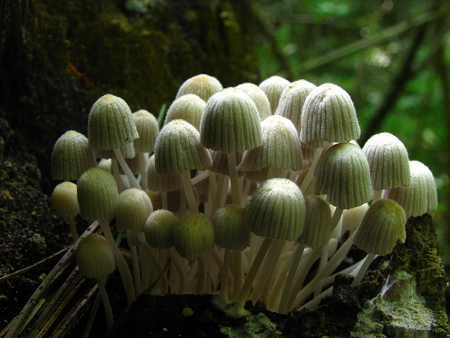CC 3.0 Dan Molter
The non-inky coprinus, Coprinellus disseminatus (Pers.) J.E. Lange.
Synonyms
Agaricus disseminatus Pers.
Syn. meth. fung. (Göttingen) 2: 403 (1801)
Agaricus disseminatus Pers.
Syn. meth. fung. (Göttingen) 2: 403 (1801) var. disseminatus
Agaricus striatus sensu Sowerby [Col. Fig. Engl. Fung. Vol. 2, pl. 166 (1798)]
fide Checklist of Basidiomycota of Great Britain and Ireland (2005)
Coprinarius disseminatus (Pers.) P. Kumm.
Führ. Pilzk. (Zwickau): 68 (1871)
Coprinus disseminatus (Pers.) Gray
Nat. Arr. Brit. Pl. (London) 1: 634 (1821)
Psathyrella disseminata (Pers.) Quél.
Mém. Soc. Émul. Montbéliard, Sér. 2 5: 123 (1872)
Pseudocoprinus disseminatus (Pers.) Kühner
Le Botaniste 20: 156 (1928)
Common names
Non-inky coprinus
Fairy bonnet
Little helmets
Crumble cap
Description
Cap: 0.5-2 cm diameter, conic to campanulate, yellow-brown to grey-brown, striate or with pleats over the margin; covered with minute glistening particles when young, but glabrous when mature. Flesh very soft, thin, pale buff.
Gills: adnate or free, distant, narrow, white when young, grey to black in age, not deliquescing to the same extent as other Coprinellus species.
Stem: 2-4 cm long, 0.1-0.2 cm thick, equal, curved, surface smooth to slightly scurfy, white, hollow.
Odor and taste: not distinctive.
Spore print: black.
Spores: elliptical, smooth, thick-walled, with an apical pore, nonamyloid, 7-10 x 4-6 µm.
Habitat: found growing gregariously in dense troops on well-rotted wood or buried wood, or at the base of standing dead trees. Fruiting in spring, summer and fall.
Edibility: edible (i.e., non-poisonous) but small and insubstantial.
Fruiting bodies are very fragile and likely to crumble on contact.
Medicinal properties
Antitumor effects
Extracts of the mycelial culture of Coprinellus disseminatus inhibits proliferation and induces apoptosis in human cervical carcinoma cells by activation of caspase, a key protein involved in the regulation of apoptosis (Han et al., 1999).
Polysaccharides extracted from the mycelial culture of C. disseminatus and administered intraperitoneally into white mice at a dosage of 300 mg/kg inhibited the growth of Sarcoma 180 and Ehrlich solid cancers by 100% and 90%, respectively (Ohtsuka et al., 1973).

My name is Austin Collins.
I've dedicated my life to Mushrooms.
I believe Mushrooms are the best kept secret when it comes to health and well being.
For that reason, I would like to share a company with you that in my opinion makes the best mushroom products on the market.
The company is called Noomadic Herbals, my favorite supplement they make is called "Mushroom Total".
I take their products every day and they have helped me think better and have more energy. Give them a try.
-Austin
Links
Mushroom Expert
California Fungi
References
Han BY, Toyomasu T, Shinozawa T.
Induction of apoptosis by Coprinus disseminatus mycelial culture broth extract in human cervical carcinoma cells.
Cell Structure and Function 24(4):209-15.
Ohtsuka S, Ueno S, Yoshikumi C, Hirose F, Ohmura Y, Wada T, Fujii T, Takahashi E. Polysaccharides having an anticarcinogenic effect and a method of producing them from species of Basidiomycetes. UK Patent 1331513, 26 September 1973.




Hi. I could harvest hoards of these. Can I make a tincture from them? Or should I just leave them. Please respond asap… Thank you
You could, yes. It’s not really a mushroom in high regard though, it’s insubstantial.
Hi. I am growing an above ground garden with four lima bean plants and I see a couple of these mushrooms growing. Do they need to be removed? I am noticing two of the plants are dying but I don’t know if it is from these mushrooms as I just found them today. Please respond ASAP
Mushrooms can definitely kill plants by eating the nutrients the plants need.
So, does this mean they kill cancer cells?
Hi Julie,
I can’t confirm that. We need to wait for peer reviewed studies to suggest something like this.